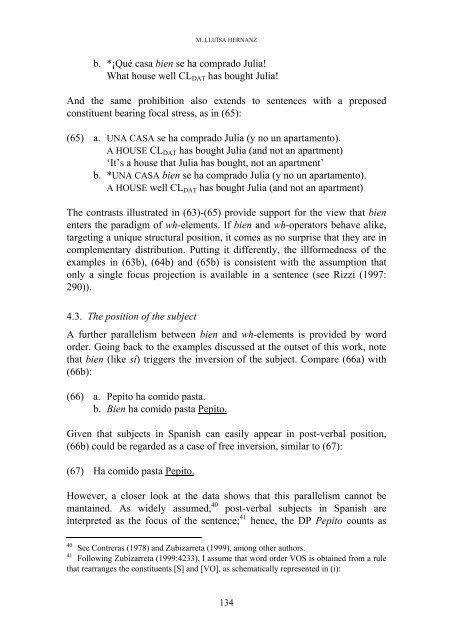Emphatic Polarity and C in Spanish - Lear
Emphatic Polarity and C in Spanish - Lear
Emphatic Polarity and C in Spanish - Lear
You also want an ePaper? Increase the reach of your titles
YUMPU automatically turns print PDFs into web optimized ePapers that Google loves.
M. LLUÏSA HERNANZ<br />
b. *¡Qué casa bien se ha comprado Julia!<br />
What house well CLDAT has bought Julia!<br />
And the same prohibition also extends to sentences with a preposed<br />
constituent bear<strong>in</strong>g focal stress, as <strong>in</strong> (65):<br />
(65) a. UNA CASA se ha comprado Julia (y no un apartamento).<br />
A HOUSE CLDAT has bought Julia (<strong>and</strong> not an apartment)<br />
‘It’s a house that Julia has bought, not an apartment’<br />
b. *UNA CASA bien se ha comprado Julia (y no un apartamento).<br />
A HOUSE well CLDAT has bought Julia (<strong>and</strong> not an apartment)<br />
The contrasts illustrated <strong>in</strong> (63)-(65) provide support for the view that bien<br />
enters the paradigm of wh-elements. If bien <strong>and</strong> wh-operators behave alike,<br />
target<strong>in</strong>g a unique structural position, it comes as no surprise that they are <strong>in</strong><br />
complementary distribution. Putt<strong>in</strong>g it differently, the illformedness of the<br />
examples <strong>in</strong> (63b), (64b) <strong>and</strong> (65b) is consistent with the assumption that<br />
only a s<strong>in</strong>gle focus projection is available <strong>in</strong> a sentence (see Rizzi (1997:<br />
290)).<br />
4.3. The position of the subject<br />
A further parallelism between bien <strong>and</strong> wh-elements is provided by word<br />
order. Go<strong>in</strong>g back to the examples discussed at the outset of this work, note<br />
that bien (like sí) triggers the <strong>in</strong>version of the subject. Compare (66a) with<br />
(66b):<br />
(66) a. Pepito ha comido pasta.<br />
b. Bien ha comido pasta Pepito.<br />
Given that subjects <strong>in</strong> <strong>Spanish</strong> can easily appear <strong>in</strong> post-verbal position,<br />
(66b) could be regarded as a case of free <strong>in</strong>version, similar to (67):<br />
(67) Ha comido pasta Pepito.<br />
However, a closer look at the data shows that this parallelism cannot be<br />
manta<strong>in</strong>ed. As widely assumed, 40 post-verbal subjects <strong>in</strong> <strong>Spanish</strong> are<br />
<strong>in</strong>terpreted as the focus of the sentence; 41 hence, the DP Pepito counts as<br />
40 See Contreras (1978) <strong>and</strong> Zubizarreta (1999), among other authors.<br />
41 Follow<strong>in</strong>g Zubizarreta (1999:4233), I assume that word order VOS is obta<strong>in</strong>ed from a rule<br />
that rearranges the constituents [S] <strong>and</strong> [VO], as schematically represented <strong>in</strong> (i):<br />
134

















